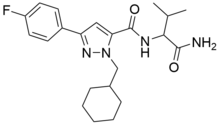Gettinglit (talk | contribs) No edit summary |
Gettinglit (talk | contribs) mNo edit summary |
||
| Line 39: | Line 39: | ||
'''AB-CHFUPYCA''' (also '''AB-CHMFUPPYCA''')<ref name=McLaughlin>{{cite journal | vauthors = McLaughlin G, Morris N, Kavanagh PV, Power JD, Twamley B, O'Brien J, Talbot B, Dowling G, Brandt SD | display-authors = 6 | title = The synthesis and characterization of the 'research chemical' N-(1-amino-3-methyl-1-oxobutan-2-yl)-1-(cyclohexylmethyl)-3-(4-fluorophenyl)-1H-pyrazole-5-carboxamide (3,5-AB-CHMFUPPYCA) and differentiation from its 5,3-regioisomer | journal = Drug Testing and Analysis | volume = 8 | issue = 9 | pages = 920–9 | date = September 2016 | pmid = 26360802 | doi = 10.1002/dta.1864 | url = http://researchonline.ljmu.ac.uk/3149/1/DTA-15-0206.R1.pdf }}</ref> is a compound that was first identified as a component of [[synthetic cannabis]] products in Japan in 2015.<ref>{{cite journal | vauthors = Uchiyama N, Asakawa K, Kikura-Hanajiri R, Tsutsumi T, Hakamatsuka T | title=A new pyrazole-carboxamide type synthetic cannabinoid AB-CHFUPYCA [''N''-(1-amino-3-methyl-1-oxobutan-2-yl)-1-(cyclohexylmethyl)-3-(4-fluorophenyl)-1''H''-pyrazole-5-carboxamide] identified in illegal products | journal=Forensic Toxicology | volume=33 | issue=2 | pages=367–373 | doi=10.1007/s11419-015-0283-8 | date=August 2015| s2cid=20718579 }}</ref><ref>{{cite journal | vauthors = Franz F, Angerer V, Brandt SD, McLaughlin G, Kavanagh PV, Moosmann B, Auwärter V | title = In vitro metabolism of the synthetic cannabinoid 3,5-AB-CHMFUPPYCA and its 5,3-regioisomer and investigation of their thermal stability | journal = Drug Testing and Analysis | volume = 9 | issue = 2 | pages = 311–316 | date = February 2017 | pmid = 26888282 | doi = 10.1002/dta.1950 | url = http://researchonline.ljmu.ac.uk/id/eprint/3141/3/dta1950-sup-0001-Supplementary.pdf }}</ref> The name "'''AB-CHFUPYCA'''" is an acronym of its systematic name ''N''-(1-'''A'''mino-3-methyl-1-oxo'''B'''utan-2-yl)-1-('''C'''yclo'''H'''exylmethyl)-3-(4-'''F'''l'''U'''orophenyl)-1''H''-'''PY'''razole-5-'''C'''arbox'''A'''mide. There are two known regioisomers of AB-CHFUPYCA: 3,5-AB-CHMFUPPYCA (pictured) and 5,3-AB-CHMFUPPYCA.<ref>{{cite web | url=https://www.caymanchem.com/product/18296 | title=5-fluoro-3,5-AB-PFUPPYCA | publisher=Cayman Chemical Company | access-date=25 May 2017}}</ref> The article[1] refers to both 3,5-AB-CHMFUPPYCA and 5,3-AB-CHMFUPPYCA as AB-CHMFUPPYCA isomers, so AB-CHMFUPPYCA and AB-CHFUPYCA are not names for a unique chemical structure. |
'''AB-CHFUPYCA''' (also '''AB-CHMFUPPYCA''')<ref name=McLaughlin>{{cite journal | vauthors = McLaughlin G, Morris N, Kavanagh PV, Power JD, Twamley B, O'Brien J, Talbot B, Dowling G, Brandt SD | display-authors = 6 | title = The synthesis and characterization of the 'research chemical' N-(1-amino-3-methyl-1-oxobutan-2-yl)-1-(cyclohexylmethyl)-3-(4-fluorophenyl)-1H-pyrazole-5-carboxamide (3,5-AB-CHMFUPPYCA) and differentiation from its 5,3-regioisomer | journal = Drug Testing and Analysis | volume = 8 | issue = 9 | pages = 920–9 | date = September 2016 | pmid = 26360802 | doi = 10.1002/dta.1864 | url = http://researchonline.ljmu.ac.uk/3149/1/DTA-15-0206.R1.pdf }}</ref> is a compound that was first identified as a component of [[synthetic cannabis]] products in Japan in 2015.<ref>{{cite journal | vauthors = Uchiyama N, Asakawa K, Kikura-Hanajiri R, Tsutsumi T, Hakamatsuka T | title=A new pyrazole-carboxamide type synthetic cannabinoid AB-CHFUPYCA [''N''-(1-amino-3-methyl-1-oxobutan-2-yl)-1-(cyclohexylmethyl)-3-(4-fluorophenyl)-1''H''-pyrazole-5-carboxamide] identified in illegal products | journal=Forensic Toxicology | volume=33 | issue=2 | pages=367–373 | doi=10.1007/s11419-015-0283-8 | date=August 2015| s2cid=20718579 }}</ref><ref>{{cite journal | vauthors = Franz F, Angerer V, Brandt SD, McLaughlin G, Kavanagh PV, Moosmann B, Auwärter V | title = In vitro metabolism of the synthetic cannabinoid 3,5-AB-CHMFUPPYCA and its 5,3-regioisomer and investigation of their thermal stability | journal = Drug Testing and Analysis | volume = 9 | issue = 2 | pages = 311–316 | date = February 2017 | pmid = 26888282 | doi = 10.1002/dta.1950 | url = http://researchonline.ljmu.ac.uk/id/eprint/3141/3/dta1950-sup-0001-Supplementary.pdf }}</ref> The name "'''AB-CHFUPYCA'''" is an acronym of its systematic name ''N''-(1-'''A'''mino-3-methyl-1-oxo'''B'''utan-2-yl)-1-('''C'''yclo'''H'''exylmethyl)-3-(4-'''F'''l'''U'''orophenyl)-1''H''-'''PY'''razole-5-'''C'''arbox'''A'''mide. There are two known regioisomers of AB-CHFUPYCA: 3,5-AB-CHMFUPPYCA (pictured) and 5,3-AB-CHMFUPPYCA.<ref>{{cite web | url=https://www.caymanchem.com/product/18296 | title=5-fluoro-3,5-AB-PFUPPYCA | publisher=Cayman Chemical Company | access-date=25 May 2017}}</ref> The article[1] refers to both 3,5-AB-CHMFUPPYCA and 5,3-AB-CHMFUPPYCA as AB-CHMFUPPYCA isomers, so AB-CHMFUPPYCA and AB-CHFUPYCA are not names for a unique chemical structure. |
||
AB-CHFUPYCA contains some similar structural elements to other synthetic cannabinoids such as [[JWH-307]], [[JWH-147]] |
AB-CHFUPYCA contains some similar structural elements to other synthetic cannabinoids such as [[JWH-307]], [[JWH-147]], [[AB-PINACA]] and [[AB-FUBINACA]]. It can be considered a structural analog of the traditional [[pyrazole]] cannabinoid receptor 1 antagonist [[rimonabant]]. The pharmacological properties of AB-CHFUPYCA have not been studied. |
||
== See also == |
== See also == |
||
Revision as of 21:57, 17 April 2022
 | |
| Legal status | |
|---|---|
| Legal status |
|
| Identifiers | |
| |
| CAS Number |
|
| Chemical and physical data | |
| Formula | C22H29FN4O2 |
| Molar mass | 400.498 g·mol−1 |
| 3D model (JSmol) | |
| |
| |
AB-CHFUPYCA (also AB-CHMFUPPYCA)[1] is a compound that was first identified as a component of synthetic cannabis products in Japan in 2015.[2][3] The name "AB-CHFUPYCA" is an acronym of its systematic name N-(1-Amino-3-methyl-1-oxoButan-2-yl)-1-(CycloHexylmethyl)-3-(4-FlUorophenyl)-1H-PYrazole-5-CarboxAmide. There are two known regioisomers of AB-CHFUPYCA: 3,5-AB-CHMFUPPYCA (pictured) and 5,3-AB-CHMFUPPYCA.[4] The article[1] refers to both 3,5-AB-CHMFUPPYCA and 5,3-AB-CHMFUPPYCA as AB-CHMFUPPYCA isomers, so AB-CHMFUPPYCA and AB-CHFUPYCA are not names for a unique chemical structure.
AB-CHFUPYCA contains some similar structural elements to other synthetic cannabinoids such as JWH-307, JWH-147, AB-PINACA and AB-FUBINACA. It can be considered a structural analog of the traditional pyrazole cannabinoid receptor 1 antagonist rimonabant. The pharmacological properties of AB-CHFUPYCA have not been studied.
See also
References
- ^ McLaughlin G, Morris N, Kavanagh PV, Power JD, Twamley B, O'Brien J, et al. (September 2016). "The synthesis and characterization of the 'research chemical' N-(1-amino-3-methyl-1-oxobutan-2-yl)-1-(cyclohexylmethyl)-3-(4-fluorophenyl)-1H-pyrazole-5-carboxamide (3,5-AB-CHMFUPPYCA) and differentiation from its 5,3-regioisomer" (PDF). Drug Testing and Analysis. 8 (9): 920–9. doi:10.1002/dta.1864. PMID 26360802.
- ^ Uchiyama N, Asakawa K, Kikura-Hanajiri R, Tsutsumi T, Hakamatsuka T (August 2015). "A new pyrazole-carboxamide type synthetic cannabinoid AB-CHFUPYCA [N-(1-amino-3-methyl-1-oxobutan-2-yl)-1-(cyclohexylmethyl)-3-(4-fluorophenyl)-1H-pyrazole-5-carboxamide] identified in illegal products". Forensic Toxicology. 33 (2): 367–373. doi:10.1007/s11419-015-0283-8. S2CID 20718579.
- ^ Franz F, Angerer V, Brandt SD, McLaughlin G, Kavanagh PV, Moosmann B, Auwärter V (February 2017). "In vitro metabolism of the synthetic cannabinoid 3,5-AB-CHMFUPPYCA and its 5,3-regioisomer and investigation of their thermal stability" (PDF). Drug Testing and Analysis. 9 (2): 311–316. doi:10.1002/dta.1950. PMID 26888282.
- ^ "5-fluoro-3,5-AB-PFUPPYCA". Cayman Chemical Company. Retrieved 25 May 2017.